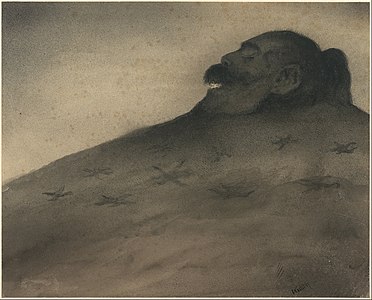Alfred Kubin
Alfred Kubin | |
|---|---|
Munich Academy | |
| Known for | Painting |
| Movement | Symbolism, Expressionism |
Alfred Leopold Isidor Kubin (10 April 1877 – 20 August 1959) was an Austrian
Biography
Kubin was born in

Kubin is considered an important representative of Symbolism and Expressionism and is noted for dark, spectral, symbolic fantasies, often assembled into thematic series of drawings. Like Oskar Kokoschka and Albert Paris Gütersloh, Kubin had both artistic and literary talent. He illustrated works of Edgar Allan Poe, E. T. A. Hoffmann, and Fyodor Dostoevsky, among others. Kubin also illustrated the German fantasy magazine Der Orchideengarten.[3][4]
From 1906 until his death, he lived a withdrawn life in a Manor-House on a 12th-century estate in
.The Other Side
Kubin's only literary work was Die andere Seite (transl. The Other Side) (1908), a fantastic novel set in an oppressive imaginary land.[6][7][8][9] The novel has an atmosphere of claustrophobic absurdity similar to the writings of Franz Kafka, who admired the book.[4][10] The illustrations for the book were originally intended for The Golem by Gustav Meyrink, but as that book was delayed, Kubin instead worked his illustrations into his own novel.[3]
Nazi-looted art
In 2016, the
The German Lost Art Foundation lists 24 artworks by Kubin in its database, many of which are from the Found-Object Reports from the Staatliche Kunstsammlungen Dresden Kupferstichkabinett in Dresden[12] which launched Nazi-era provenance research in 2008.[13]
Honours and awards
- City of Vienna Prize for Visual Arts (1950)
- Grand Austrian State Prize for Visual Art(1951)
- Austrian Medal for Science and Art(1957)
- Gustav Klimt badge as an honorary member of the Vienna Secession
Collections
- Kubin's Dance of Death and Other Drawings (1973) (art collection) (ISBN 9780486228846)
- The Life and Art of Alfred Kubin (2017) (autobiography) (ISBN 9780486815305)
Gallery
-
The State (1899–1900)
-
Dolmen (c. 1900–1902), Indian ink, wash, spray paint, and white body color, Albertina, Vienna
-
A Dream Visits us Every Night (1900)
-
The Past Forgotten Swallowed (1901)
-
The Lady on the Horse (1901), pen, ink, wash and spray
-
The Last King (1902)
-
The Moment of Birth (1902)
-
Siberian Fairy Tale (1902)
-
Angst (1903)
-
Black Mass (1905)
See also
Notes
- ^ ISBN 978-1-884446-05-4. Retrieved 16 April 2020.
- ^ a b Arnason & Wheeler 1986, p. 88.
- ^ a b Siegfried Schödel, Studien zu den phantastischen Erzählungen Gustav Meyrinks, Universität Erlangen-Nürnberg, 1965, (p.27).
- ^ a b c Rosenberg, Karen. 15 October 2008. Mapping the Shadowy Corners of the Subconscious. The New York Times. Retrieved 3 April 2012.
- ^ Karl-Heinz Meissner, Alfred Kubin, Städtische Galerie im Lenbachhaus München, Edition Spangenberg, 1990 (p.114).
- ^ "Artist creates a nightmare novel". The Canberra Times. Australian Capital Territory, Australia. 24 October 1970. p. 13. Retrieved 30 March 2020 – via Trove.
- ^ Robyn Walton (2011), The Crime of Material Culture, the Condition of the Colonies and Utopian/Dystopian Impulses, 1908-10, retrieved 30 March 2020
- ISBN 978-0-575-00345-3)
{{citation}}: CS1 maint: multiple names: authors list (link) CS1 maint: numeric names: authors list (link - ^ Kubin, Alfred, The Life and Art of Alfred Kubin, Dover 2017 (Bibliographic note). Viewable through Amazon.com's Look Inside feature for the book.
- ISBN 0-02-053560-0
- ^ "16 drawings by Alfred Kubin restituted to the heirs of Max and Hertha Morgenstern". www.lootedart.com. Archived from the original on 24 June 2020. Retrieved 5 June 2021.
On 15 May 2019 sixteen drawings by Alfred Kubin were restituted by the Städtische Galerie im Lenbachhaus Munich to the heirs of Max and Hertha Morgenstern of Vienna with the assistance of the Commission for Looted Art in Europe. The drawings were sold under duress in Vienna in July 1938 to Kurt Otte, a Kubin collector in Hamburg. In 1971 his archive and collection were sold to the Lenbachhaus in Munich where the sixteen drawings remained, with the Morgenstern stamp, and together with the documents of the 1938 sale, until their restitution in May 2019. Max Morgenstern was one of the earliest collectors of Kubin and the artist's first major patron.
- ^ "Lost Art Internet Database - Advanced Search". www.lostart.de. Archived from the original on 5 June 2021. Retrieved 5 June 2021.
- ^ "Staatliche Kunstsammlungen Dresden - Provenance Research". 5 November 2016. Archived from the original on 5 November 2016. Retrieved 5 June 2021.
References
- Arnason, H. H., & Wheeler, D. (1986). History of Modern Art: Painting, Sculpture, Architecture, Photography. Englewood Cliffs, N.J.: Prentice-Hall. ISBN 9780133903607
- Assman, Peter Alfred Kubin 1877–1959. Exhibition catalogue Brussels (Ixelles) 1997
- Alfred Kubin. Exhibition catalogue Neue Galerie New York 2008
- Romana Schuler Alfred Kubin, Aus meinem Reich. Exhibition catalogue Leopold Museum Vienna 2003
- Traumgestalten. 100 Meisterwerke aus dem Besitz der Graphischen Sammlung Albertina. Vienna 1990
External links
- Works by Alfred Kubin at Project Gutenberg
- Works by or about Alfred Kubin at Internet Archive
- www.alfred-kubin.com (in German)
- Stefan Üner: Alfred Kubin. Bewusst in Unbewusste, in: Parnass, Vienna 2019
- Water Spirit: oil painting by Alfred Kubin
- Die Blaetter mit dem Tod: book of prints by Alfred Kubin at the Leo Baeck Institute, New York
- More than 200 paintings and drawings by Alfred Kubin
- Alfred Kubin at Library of Congress, with 110 library catalogue records










